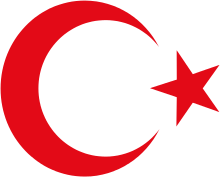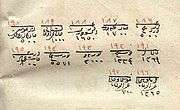Yörüks
| Regions with significant populations | |
|---|---|
| Southern Anatolia, Taurus Mountains, South Eastern Anatolia | |
| Languages | |
| Turkish | |
| Religion | |
| Sunni Islam, Alevism | |
| Related ethnic groups | |
| Turkish people and other Turkic peoples |
| Part of a series of articles on |
| Turkish people |
|---|
 |
|
The Yörüks, also Yuruks or Yorouks (Turkish: Yörük; Greek: Γιουρούκοι, Youroúkoi; Bulgarian: юруци; Macedonian: Јуруци, juruci), are a Turkish ethnic group,[1] some of whom are nomadic, primarily inhabiting the mountains of Anatolia, and partly in the Balkan peninsula. Their name derives from the Turkish verb yürü- (yürümek in infinitive), which means "to walk", with the word yörük or yürük designating "those who walk on the hindlegs, walkers".[2][3] Yörüks lived within the Yörük Sanjak (Turkish: Yörük Sancağı) which was not a territorial unit like other sanjaks but a separate organisational unit of the Ottoman Empire.[4][5]
Yörüks in Anatolia

Historians and ethnologists often use the additional appellative 'Yörük Turcoman' or 'Turkmens' to describe the Yörüks of Anatolia. In Turkey's general parlance today, the terms "Türkmen" and "Yörük" indicate the gradual degrees of preserved attachment with the former semi-nomadic lifestyle of the populations concerned, with the "Turkmen" now leading a fully sedentary life, while keeping parts of their heritage through folklore and traditions, in arts like carpet-weaving, with the continued habit of keeping a yayla house for the summers, sometimes in relation to the Alevi community etc. and with Yörüks maintaining a yet stronger association with nomadism. These names ultimately hint to their Oghuz Turkish roots. The remaining transhumant or "true" Yörüks of today's Anatolian region traditionally use the camel as a means of transportation, though these are steadily being replaced by trucks.
The Yörüks are divided in a large number of named endogamous patrilineal tribes (aşiret). Among recent tribes mentioned in the literature are Aksigirli, Ali Efendi, Bahsıs, Cakallar, Coşlu, Qekli, Gacar, Güzelbeyli, Horzum, Karaevli, Karahacılı, Karakoyunlu, Karakayalı, Karalar, Karakecili, Manavlı, Melemenci, San Agalı, Sanhacılı, Sarıkeçili, Tekeli and Yeni Osmanlı. The tribes are splittered in clans or lineages, i.e. kabile, sülale or oba.[6]
Yörüks in the Balkans
In 1911,[7] the Yörük were distinct segment of the population of Macedonia and Thrace where they settled as early as the 14th century. An earlier offshoot of the Yörüks, the Kailar or Kayılar Turks, were amongst the first settlements in Europe.[7]
Yörüks and Sarakatsani
Their nomadic way of life and the fact that they spread through the Balkans led Arnold van Gennep to try to establish a connection between the Yörüks and the ethnically Greek Sarakatsani (Greek: Σαρακατσάνοι) or Karakachans of Greece.[8] However, the Sarakatsani when for the first time mentioned under this name were Orthodox Christians and speaking Greek. While there are no actual linguistic or religious links to the Yörük, there are nevertheless connections and similarities as to the transhumant, nomadic way of life.[9]
Kayılar Yörüks

The Kailar Turks formerly inhabited parts of Thessaly and Macedonia (especially near the town of Kozani and modern Ptolemaida). Before 1360, large numbers of nomad shepherds, or Yörüks, from the district of Konya, in Asia Minor, had settled in the country; their descendants are still known as "Konariotes" in Greek. Further immigration from this region took place from time to time up to the middle of the 18th century. After the establishment of the feudal system in 1397 many of the Seljuk noble families came over from Asia Minor; some of the beys or Muslim landowners in southern Macedonia before the Balkan Wars may have been their descendants.[10]
Yörüks in Iran
Clans closely related to the Yörüks are scattered throughout the Anatolian peninsula and beyond its boundaries, particularly around the chain of Taurus Mountains and further east around the shores of the Caspian sea. Of the Turcomans of Iran, the Yomuts come the closest to the definition of the Yörüks. An interesting offshoot of the Yörük mass are the Tahtadji of the mountainous regions of Western Anatolia who, as their name implies, have been occupied with forestry work and wood craftsmanship for centuries. Despite this, they share similar traditions (with markedly matriarchal tones in their society structure) with their other Yörük cousins. The Qashqai people of southern Iran are also worthy of mention due to their shared characteristics.
Gallery
 Kailar (Kayılar), Yörük baby in traditional taç
Kailar (Kayılar), Yörük baby in traditional taç_p010_YOUROUK_ENCAMPMENT_IN_THE_TAURUS.jpg) Yörük camp in the Taurus Mountains, c. 1879
Yörük camp in the Taurus Mountains, c. 1879 Yörük encampment, c. 1893
Yörük encampment, c. 1893
.jpg) The first settlements of Kailar Yörüks in Erdemuş
The first settlements of Kailar Yörüks in Erdemuş Kailar Yörüks in center of Kailar as a formal name of Cuma Pazarı
Kailar Yörüks in center of Kailar as a formal name of Cuma Pazarı
See also
Notes
- ↑ Vakalopoulos, Apostolos Euangelou. " Origins of the Greek Nation: The Byzantine Period, 1204-1461". Rutgers University Press, 1970. web link, p. 163, p. 330
- ↑ Turkish Language Association - TDK Online Dictionary. Yorouk Archived April 4, 2009, at the Wayback Machine., yorouk Archived April 4, 2009, at the Wayback Machine. (Turkish)
- ↑ "yuruk." Webster's Third New International Dictionary, Unabridged. Merriam-Webster. 2002.
- ↑ Сима Ћирковић; Раде Михаљчић (1999). Лексикон српског средњег века. Knowledge. p. 645. Retrieved 23 March 2013.
Посебни санџак-бегови управљали су санџаци- ма који нису представљали територијалне, него само организационе јединице неких војничких и друштвених редова (војнуци, акинџије, Јуруци, Цигани)
- ↑ Aleksandar Matkovski (1983). Otpor na Makedonija vo vremeto na turskoto vladeenje. Misla. p. 372. Retrieved 23 March 2013.
Нај-голема организациона единица на таквите општествени редови како што биле војнуци, акинџии, Јуруци, Роми, Власи кои имале своја посебна организација и [...]
- ↑ Materialia Turcica, vol. 5-8, Studienverlag Brockmeyer., 1981, p.25
- 1 2
 Bourchier, James David (1911). "Macedonia#Races". In Chisholm, Hugh. Encyclopædia Britannica. 17 (11th ed.). Cambridge University Press.
Bourchier, James David (1911). "Macedonia#Races". In Chisholm, Hugh. Encyclopædia Britannica. 17 (11th ed.). Cambridge University Press. - ↑ Ethnic groups worldwide: a ready reference handbook By David Levinson page 41 :” Sarakatsani are Greek-speaking people in northwestern Greece and southern Bulgaria. They number less than 100 thousand , are ethnically Greek, speak Greek, and are Greek orthodox.”
- ↑ Kavadias, Georges B. (1965). Pasteurs-Nomades Mediterraneens: Les Saracatsans de Grèce (in French). Gauthier-Villars. p. 6. Retrieved 2008-11-17.
Gennep T, les considère (mais à titre d'hypothèse) comme des descendants des Turcs, installés dans le pays.
- ↑
 One or more of the preceding sentences incorporates text from a publication now in the public domain: Bourchier, James David (1911). "Macedonia". In Chisholm, Hugh. Encyclopædia Britannica. 17 (11th ed.). Cambridge University Press.
One or more of the preceding sentences incorporates text from a publication now in the public domain: Bourchier, James David (1911). "Macedonia". In Chisholm, Hugh. Encyclopædia Britannica. 17 (11th ed.). Cambridge University Press.
References
 Bourchier, James David (1911). "Macedonia". In Chisholm, Hugh. Encyclopædia Britannica. 17 (11th ed.). Cambridge University Press.
Bourchier, James David (1911). "Macedonia". In Chisholm, Hugh. Encyclopædia Britannica. 17 (11th ed.). Cambridge University Press.- Brailsford, H.N. Macedonia: Its Races and Their Future. Methuen & Co., London, 1906. Kailar Turks
- Cribb, Roger. Nomads in Archaeology. Cambridge University Press, 2004.
External links
| Look up yörük in Wiktionary, the free dictionary. |
| Wikimedia Commons has media related to Yörük. |
- Web portal for information sharing on and between Yörüks
- The disappearing Yörük and their music
- Foundation of Yörüks in Turkey